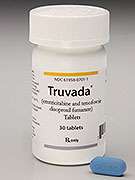More than 1 in 4 new HIV infections in U.S. in 2009 involved heterosexuals, research shows.
(HealthDay) -- Doctors should consider prescribing the HIV prevention pill Truvada to their heterosexual patients who are at high risk for the virus, not just high-risk gay and bisexual men, experts from the U.S. Centers for Disease Control and Prevention said on Thursday.
The CDC announcement comes on the heels of recent research that revealed that 27 percent of new HIV cases in the United States in 2009 involved heterosexuals who were not injection-drug users. Based on these findings, government health officials advised that the once-a-day pill can also help prevent HIV infection in high-risk heterosexual men and women.
Last month, the U.S. Food and Drug Administration approved the use of Truvada for the reduction of risk for sexual acquisition of HIV infection among adults, including both heterosexuals and gay or bisexual men.
The newly updated CDC guidelines are an attempt to prevent the spread of HIV through heterosexual sex. U.S. health officials noted that Truvada, when taken regularly in combination with other preventative measures, can offer an additional layer of protection for heterosexual men and women at high risk for infection with the virus that causes AIDS.
The CDC is not recommending Truvada for all heterosexuals who are sexually active, and they stress that the condom remains a good first line of defense against HIV. However, couples in which one member is HIV-positive and the other is uninfected may look to Truvada as an option in addition to condom use. And if such a couple wanted to have a baby, Truvada might be a good option in that case as well, Dr. Dawn Smith, the CDC physician who was lead author of the new guidance, told the Associated Press.
CDC officials advised, however, that doctors who consider prescribing the anti-HIV drug for their high-risk heterosexual patients should be certain these men and women are not already infected with the virus. Doctors should also continuously monitor their patients' HIV status and provide this high-risk group with regular counseling on other ways to prevent the spread of HIV, such as practicing safe sex.
High-risk heterosexuals are "not a portion of the epidemic we want to ignore," Smith, of the CDC's National Center for HIV/AIDS, Viral Hepatitis, STD and TB Prevention, told AP.
When used as a preventive, the daily pill costs between $6,000 and $12,000 a year, although some private insurers and Medicaid programs may cover it, Smith added.
Although Truvada, made by Gilead Sciences, has been approved since 2004, the CDC authors noted that guidelines on the use of the drug will be updated as more information on its efficacy and safety for all groups at risk for HIV becomes available from additional studies.
In the United States, an estimated 48,100 new HIV infections occurred in 2009, the authors noted in background information in the report, which was published in the Aug. 10 issue of the CDC's Morbidity and Mortality Weekly Report.
More information:
Find out more about HIV/AIDS at AIDS.gov.
Journal information: Morbidity and Mortality Weekly Report
Copyright © 2012 HealthDay. All rights reserved.





















